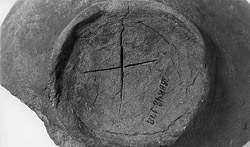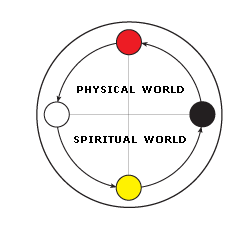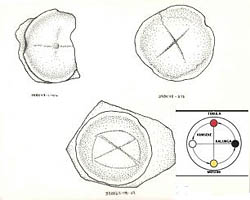Magic Bowls
© (Ferguson 1999)
Historians argue that crosses and circles in certain contemporary African American rituals were derived from depictions of the cosmos traditional among Bakongo priests from the southwest coast of Africa (Thompson 1983:110,121; Stuckey 1983: 3–97). The basic form of this cosmogram is a simple cross with one line representing the boundary between the living world and that of the dead, and the other representing the path of power from below to above, as well as the vertical path across the boundary. Marks on the bases of Colono Ware bowls found in river bottoms and slave quarter sites in South Carolina suggest that more than one hundred and fifty years ago African American priests used similar symbols of the cosmos.
While cataloging thousands of Colono Ware sherds, South Carolina archaeologists began noticing marks on the bases of some bowls. Most of these marks were simple crosses. In some cases a circle or rectang le enclosed the cross; in others, “arms” extended counterclockwise from the ends of the cross. On one there was a circle without a cross, and on a few others we found more complicated marks.
Initially we called these “maker’s marks” since the first ones discovered had been in cised on the vessel bases before firing and bore a resemblance to maker’s marks on European and Asian pottery. Similar marks, however, were soon found inscribed on interior bottoms, and still others were scratched into the bowls after the vessels were fired. Some archaeologists argued that they were “owner’s marks,” but there was too little variety in the marks to suggest different owners. Interpreting the marks as either “maker’s” or “owner’s” had serious flaws.
Although we could not explain what these marks meant, over a period of several years a pattern emerged linking the marks to earthenware bowls collected underwater from rivers. What we knew was this:
- The majority of marks were a cruciform or some variation of a cross or X.
- All marks were on Colono Ware bowls, none on the Colono Ware cooki ng jars we commonly found. Also, there were no such marks on imported European bowls, although slaves were using large amounts of European ware as well as Colono Ware.
- Marks always were located at the very bottom of the bowl, either on the inside or outside. Sometimes they were made before firing and in other cases after firing.
- Marks were more commonly found on bowls with ring bases than on those with rounded or flattened bases, even though ring-based bowls comprised only a small proportion of the total number of bowls recovered.
- Although marked pieces had been found around former slave quarters, most were picked up in adjacent rivers. This was true in spite of the fact that many more Colono Ware sherds had been recovered from terrestrial sites than from those underwater.
Clearly the marks were associated with bowls and with water, but what did they signify? In February 1987 at a Williamsburg symposium on African American culture, I showed illustrations of the marked pots and mentioned that while we believed these bowls were in some way associated with water, we really didn’t know how to interpret them. After the presentation, Wythe Dornman, a member of the audience, and later an associate, Elaine Nichols, called my attention to the similarity of the marks to Bakongo cosmograms.
The Bakongo are a numerous and powerful people located in the southern portion of modern Democratic Republic of Congo near the Angolan border. Their homeland is in the area identified in discussions of the Atlantic slave trade as the “Congo-Angolan region.” Bakongo culture has been so influential that many non-Bakongo people have adopted Bakongo practices, especially in religion. During the time when traders brought slaves to North America, almost half of those arriving in South Carolina came from the region of Bakongo influence.
According to Bakongo religion, an almighty God emanates power that may be controlled for either good or evil by living human beings, people who make sacred medicines or minkisi. Minkisi control the spirits of the cosmos connecting the living with the powers of the dead. Making an nkisi (plural: minkisi) involves packaging a variety of “spirit-embodying materials,” which might include cemetery earth, white clay, stones, and other items. Nkisi containers include leaves, shells, bags, wooden images, cloth bundles, and ceramic vessels (MacGaffey 1986:42–51; Thompson 1983:108–131).
Bakongo philosophers explain the land of the living as a mountain over a watery barrier separating this world from the land of the dead beneath. Each day the sun rises over the earth and proceeds in a counterclockwise direction, as viewed from the southern hemisphere, across the sky to set in the water. Then, during earthly nighttime, the sun illuminates the underside of the universe, the land of the dead, until it rises again in the northeast. The cycle continues incessantly, representing the continuity of life: birth, death, and rebirth (MacGaffey 1986:42–46; Thompson 1983:108–109).
Circularity pervades West African ideology, and the circle proved equally important in African American slave religion and art. Moreover, the watery barrier, which separates the corporal and spirit worlds, also found a weighty role in African American ideology.
Considering the West African emphasis on circularity and water spirits, and the influence of Bakongo cosmology and ritual in the Congo-Angolan region, it should not be surprising that early African American religion would bear these same characteristics. The marks on bowls picked up from river bottoms in the Carolina lowCountry strongly resemble Bakongo cosmograms. The association of marks with earthenware vessels, ring bases, and underwater sites also fits the general West African model.
South Carolina’s marked bowls were made and used by American descendants of the mythical Ne Kongo who cooked medicines in earthenware pots. Although no marks have been found on Colono Ware cooking jars or pots, some marked bowls show charring from use over a fire. Overall, the traditional African association of medicines or charms with earthenware vessels, and the exclusive archaeological association of marks with handbuilt earthenware bowls, and not with imported European ware, suggests an interpretation of the bowls as receptacles in a ritual similar to those involving minkisi.
As Africans came to the Americas they arrived with a belief in water spirits and a profound respect for the cross and circularity as symbols of life and death. Again, we can read these tenets in the archaeological record: two-thirds of the marks are unquestionably cruciform and three out of four marked bowls have been recovered from underwater, bowls that embody circularity. Not only are the bowls themselves segments of spheres, and circles the dominating lines of spheres, but the ring bases add even more circles to the vessels. When they are attached to spherical bowls, the ring bases appear as circles attached to circles; when marked they appear as circles enclosing the Bakongo cosmogram.
The archaeological pattern fits the West African model quite well. The combination of marks, handbuilt earthenware, circles, and underwater context suggest that African American priests performed traditional rituals passed from Africa to South Carolina.








